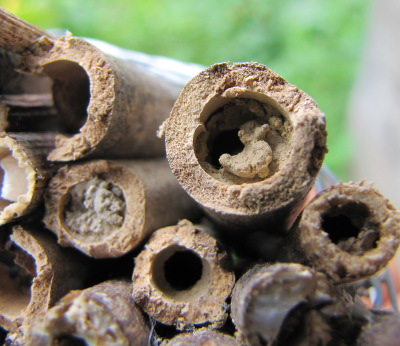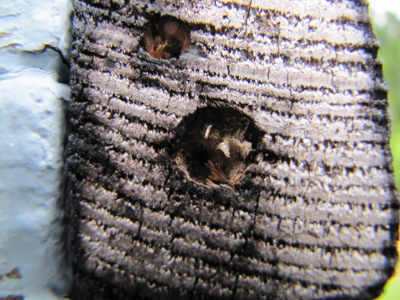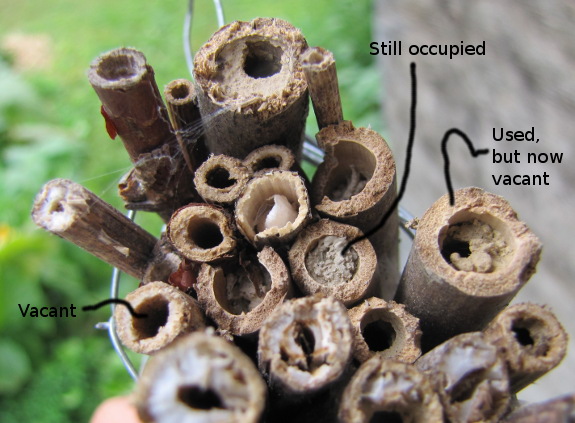
Vacancies and residents in our pollinator homes
 Last winter, I played around
with making nest sites to attract
native pollinators.
I figured there wasn't really much need since we have plenty of habitat
just a stone's throw away in the woods, but I was curious to see if
anyone would move in anyhow. Sure enough, several native bees
took advantage of the in-garden accomodations!
Last winter, I played around
with making nest sites to attract
native pollinators.
I figured there wasn't really much need since we have plenty of habitat
just a stone's throw away in the woods, but I was curious to see if
anyone would move in anyhow. Sure enough, several native bees
took advantage of the in-garden accomodations!
But first, I should tell
you what didn't work. The insects ignored my large and small
nest blocks, which I
figure is probably my own fault. The books recommend drilling the
holes with a very sharp bit, and I didn't have one  on hand, so the interiors of
the potential nest chambers were full of burrs of wood.
Meanwhile, I put all three of my experimental nest blocks in exposed
locations, meaning that rain could potentially drip in, which probably
also made the cavities less enticing.
on hand, so the interiors of
the potential nest chambers were full of burrs of wood.
Meanwhile, I put all three of my experimental nest blocks in exposed
locations, meaning that rain could potentially drip in, which probably
also made the cavities less enticing.
On the other hand, my stem
bundles saw a lot of
activity. You can tell if a native bee has moved into a nest
because you'll notice dried mud plugging the end of the cavity, perhaps
with a round hole in the mud if the inhabitants have already grown up
and flown away. The photo below illustrates the difference
between used, unused, and still occupied stems, all in the same bundle.

Since only about a third
of my stem bundles were used, I got a good idea of which sites the
insects preferred. Exposure to the elements kept bees away from
all except one stem in the peach tree hotel, but many more of the ones under
the awning of the wood stove roof showed signs of use. Bamboo
seemed to be preferable to drilled-out elderberry twigs, probably again
because my drill bit wasn't sharp enough to provide an interior as
smooth as the natural bamboo walls. It's also possible that the
bees liked the more solid ends created by the bamboo stem joints
compared to the twigs that I blocked off with mud.
I'd be curious to hear
from readers who have experimented with building nest habitat for
native pollinators. What worked and didn't work for you?
Want more in-depth information? Browse through our books.
Or explore more posts by date or by subject.
About us: Anna Hess and Mark Hamilton spent over a decade living self-sufficiently in the mountains of Virginia before moving north to start over from scratch in the foothills of Ohio. They've experimented with permaculture, no-till gardening, trailersteading, home-based microbusinesses and much more, writing about their adventures in both blogs and books.
Want to be notified when new comments are posted on this page? Click on the RSS button after you add a comment to subscribe to the comment feed, or simply check the box beside "email replies to me" while writing your comment.
